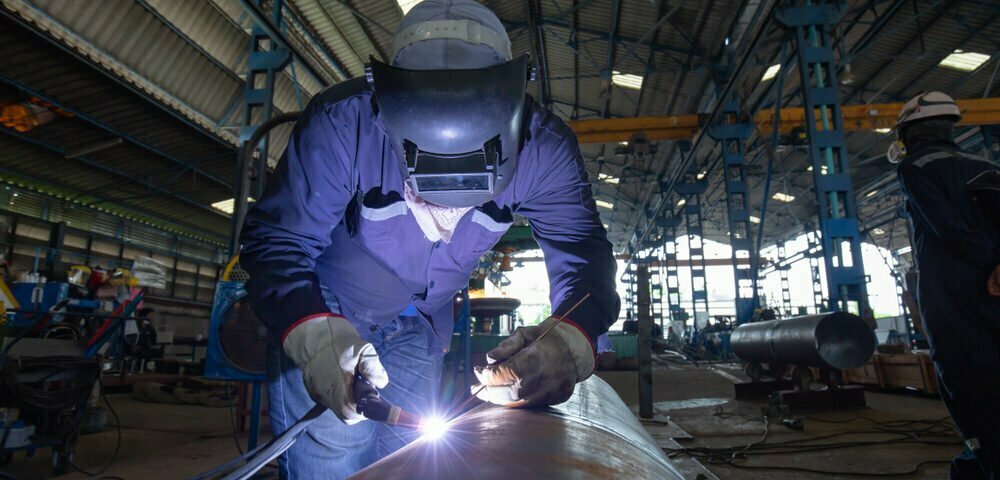Important Considerations for Welding Carbon Steel

Basics and Advantages of Duplex Steel for Utah Clients
April 1, 2022
Pre-Painted Metal and Steel Basics and Uses
May 6, 2022There are a number of processes that may be carried out when working with steel or other metals, and one of the single most common is welding. There are a number of considerations for welding any steel, and one type that requires a few specific areas of attention before you begin is within the realm of welding carbon steel.
At Wasatch Steel, we’re happy to not only offer a wide range of steel products, but also to offer MIG, ARC and TIG welding equipment for a variety of client needs. What is carbon steel, and why does it have such particular requirements for welding? Furthermore, what are the important qualities or concepts to be aware of before you begin any carbon steel welding project? Here’s a basic rundown.
Carbon Steel Basics
Before we dig into the welding-related information, it’s important to understand some basics about carbon steel. First and foremost, carbon steel is a type of steel that gets its name from the fact that it contains carbon; specifically, it has a carbon concentration between 0.04 percent and 2.1 percent by weight.
As you might imagine, this relatively high level of carbon makes carbon steel a rather brittle material; it’s also susceptible to corrosion. Because of these qualities, carbon steel is often used in the production of heavy-duty equipment and machinery. It’s also a popular choice for construction projects, particularly those that involve the use of pipes or other large objects made from steel.
Now that we’ve got a basic understanding of carbon steel, let’s move on to some of the important things you should know before beginning a welding project with this type of steel.
Carbon Content
Precisely where your carbon steel falls on the carbon content spectrum will have a big impact on the weldability of the steel. In general, carbon steel with a lower carbon content is easier to weld than carbon steel with a higher carbon content. The reason for this is that lower-carbonsteel contains less carbide, which is a compound that can interfere with the welding process.
While you might be tempted to think that the more carbon, the more difficult the weld, this isn’t always the case. In fact, there’s a “sweet spot” when it comes to carbon content in which the steel is just hard enough to be durable and withstand wear and tear but not so hard that it becomes difficult (or impossible) to weld.
In addition, because high-carbon steel (steel with carbon percentages between 0.61% and 2.1% carbon) are more susceptible for weld cracking than other steels, you’ll want to choose a low-hydrogen electrode when welding any high-carbon steel.
Carbon Equivalency
Another vital metric that’s often used to help determine whether a carbon steel product is weldable is known as the carbon equivalency. The carbon equivalency is a measure of the other elements in steel beyond carbon, and how they may impact the weldability of the product.
Typically, a higher carbon equivalent makes a steel less weldable. That’s because the other elements found in carbon steel (manganese, silicon, etc.) can create a variety of issues when welding, including hot cracking and weld metal porosity. In general, you’ll want to look for a carbon equivalency of no more than 0.4 when choosing a weldable carbon steel product.
It’s important to realize that it’s entirely possible for two separate plates of steel to have the same level of carbon, but a very different carbon equivalency. This is just one more reason to carefully consider all aspects of a carbon steel product before beginning any welding project.
Cooling Rate
Cooling rate is a vital theme across many areas of the welding world, and it’s just as important when welding carbon steel. In short, the cooling rate is simply the speed at which a welded object cools down and solidifies after being welded.
The cooling rate can have a big impact on the properties of the final weld, particularly its hardness. A slower cooling rate (such as might be found when welding inside a welding chamber) will often result in a softer, more ductile weld, while a faster cooling rate (such as would be found if the welded piece is immediately cooled with water) will lead to a harder, more brittle weld.
While there are benefits and drawbacks to both hard and soft welds, it’s generally advisable to aim for a weld that’s on the softer side. That’s because carbon steel is already quite hard and brittle, and adding a hard weld to the mix can make the final product more susceptible to cracking and breaking.
Other Composition Issues
Finally, there are certain elements sometimes found in carbon steel that simply make it impossible to weld, no matter the other qualities present. For instance, high levels of lead, sulfur, or copper make welding carbon steel next to impossible.
If you’re not sure whether the carbon steel you’re dealing with is weldable, your best bet is to have it tested by a professional lab before beginning any welding project. That way, you can be sure that you’re starting with a quality product that will allow you to produce quality welds.
Welding carbon steel is possible, but it does require more attention to detail than other types of welding. By keeping the above factors in mind, you can be sure that your next carbon steel welding project is a success.
For more on this, or to learn about any of our steel products or welding tools, speak to our team at Wasatch Steel today.



